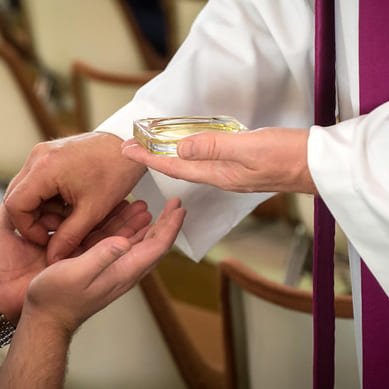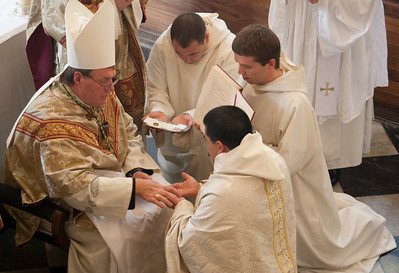Religious rituals are strange. In the Bible they were often messy with blood and oil sprinkled, splashed, and poured over altars and people.
In Exodus 29:19-20 God instructed Moses to anoint Aaron and his sons as priests by placing the blood of a sacrificed ram on their right earlobe, right thumb, and right big toe.
In Leviticus 14 the priest would perform a similar ritual with both blood and anointing oil being placed upon the right ear, thumb, and toe of someone coming to be cleansed from a sin or healed from an illness. The remaining blood and oil were often splashed or poured on the altar.
Although these rituals may seem grotesque, they can also be beautiful and rich with meaning. One among such unique rituals is the practice of anointing of hands.
So, What is this ritual of anointing of hands? What is its significance? What does the bible say about anointing hands. Well, let us see..
The Ordination Rite of Anointing Hands:

Psalm 133 only has three verses, but it depicts the blessings of God being poured out upon His people through the picture of a religious ritual:
How good and pleasant it is when God’s people live together in unity! It is like precious oil poured on the head, running down on the beard, running down on Aaron’s beard, down on the collar of his robe. It is as if the dew of Hermon were falling on Mount Zion. For there the Lord bestows his blessing, even life forevermore. – (Psalm 133:1-3, NIV)
In the modern church, much of the blood is now missing from its rituals because of the eternal and efficient sacrifice of Jesus, however, the beautiful symbolism of the church’s religious ceremonies remains. One of these rituals is the anointing of hands that is performed when a new priest is ordained into the Catholic church.
Before a priest can perform his priestly duties, he must first be consecrated and ordained by the Catholic church. In the Catholic tradition, a bishop will “anoint the hands” of a new priest for service in performing the rituals of the church.
In this way, the priest’s hands are symbolically blessed for performing the work of God through the church, including serving the elements of the Eucharist, offering God’s blessings, and anointing others for healing or ministry.
This “anointing of hands” ceremony is similar to the anointing ritual performed in the Old Testament in that the bishop places oil on the hands of the new priest (the ordinandus).
In a similar same way, Protestant ministers are ordained and set apart for service prior to fulfilling their pastoral role. When Protestant churches ordain or anoint someone for a spiritual purpose or mission, they often perform a religious ritual of placing their hand on the person’s head or shoulder as they pray for their spiritual success. Acts 13:2-3 provides a biblical example of this practice by stating, “While they were worshiping the Lord and fasting, the Holy Spirit said, “Set apart for me Barnabas and Saul for the work to which I have called them.” So, after they had fasted and prayed, they placed their hands on them and sent them off.”
Are these Catholic and Protestant ordination rituals similar or different? Are they both biblical and appropriate? What is the significance and purpose of the practice of the anointing of hands or the laying on of hands?
What is the Significance of Anointing of hands?

As I mentioned previously, when Aaron and his sons were ordained, blood was placed on their right ear, right thumb, and right big toe. Most biblical commentators believe that these signify that a servant of God must have an ear that listens to God’s voice, hands that serve God in purity, and feet that walk with God faithfully. The anointing of hands ceremony signifies and portrays at least one aspect of this Old Testament ritual. The Psalm 24:3-5 says, “Who may ascend the mountain of the Lord? Who may stand in his holy place? The one who has clean hands and a pure heart, who does not trust in an idol or swear by a false god. They will receive blessing from the Lord and vindication from God their Savior.”
Let us put this aside for a second..
As a Protestant minister, one of the most spiritually significant events of my life occurred when I was anointed as a minister of God by the church. During a special ordination service, several pastors and deacons each laid their hand on my head and prayed a blessing over me that I would faithfully perform the pastoral duties of serving God.
I also believe that God bestowed a unique spiritual gift upon me that night through the laying on of their hands. In the same way, the Apostle Paul claimed that a spiritual gift had been given to his younger prodigy, Timothy, when he was set apart for pastoral service. In 1 Timothy 4:14 Paul wrote to Timothy, “Do not neglect your gift, which was given you through prophecy when the body of elders laid their hands on you.” (See also 2 Timothy 1:6).
Was this laying on of hands ordination ritual when I became a pastor the same as the anointing of hands performed by the Catholic church when ordaining a priest? The answer is both yes and no.
First, both the Protestant and Catholic ordination ceremonies are for the purpose of setting apart someone to serve as an official representative of God and servant of His church.
For example, in the Old Testament God gave instructions concerning the ritual that was to be performed in setting apart the Levites for their service in the temple. Numbers 8:10-11 says, “You are to bring the Levites before the Lord, and the Israelites are to lay their hands on them. Aaron is to present the Levites before the Lord as a wave offering from the Israelites, so that they may be ready to do the work of the Lord.”
In a similar manner, the New Testament believers set apart individuals to serve as pastors, deacons, and missionaries through an ordination ceremony which included the laying on of hands. For example, when the church first appointed deacons in Acts 6:6 we are told, “They presented these men to the apostles, who prayed and laid their hands on them.”
While the purpose/significance of ‘anointing of hands’ and laying on of hands’ rituals is same, the way these two are performed is quite different.
Yes, the anointing of hands ceremony which is a part of the ordination rite in the Catholic church is quite differently done from the laying on of hands ritual. Well, Let’s find out how the anointing of hands is done to someone.
How are a New priest’s Hands anointed?

During his ordination service the new priest will hold his palms upward as he kneels before the Bishop, who then consecrates the hands of the priest with oil by performing the sign of the cross from thumb to index finger on both hands; since it is with the thumb and index finger by which he will hold the sacramental elements of the Eucharist.
The Bishop will then pray: May it please you, O Lord, to consecrate and sanctify these hands by this anointing and our blessing. That whatever they bless may be blessed, and whatever they consecrate may be consecrated in the name of our Lord Jesus Christ. Amen.
The Bishop then binds the new priest’s hands with a white cloth, a manutergium, which represents the burial cloth of Jesus, symbolizing that the priest is now united with Christ in sacrificial service.
Within my own Baptist church, we have performed an anointing of hands ceremony when ordaining a minister or deacon, similar to the one conferred upon a new priest by the Catholic church as described in Exodus 29. This passage in Exodus instructs us to consecrate those who will serve the Lord by anointing the person’s ears, hands, and feet. The ritual presents an outward visual image of the person’s desire to honor God with their entire life. However, unless the person has made an internal commitment to be set apart for the Lord, then the outward ritual is meaningless.
Ultimately, religious rituals are powerless, in that, in and of themselves, they cannot invoke any kind of spiritual power. The Book of Hebrews says they are shadows of something greater, yet they do serve as visible images that help convey spiritual messages. Hebrews 6:1-2 encourages us to “move beyond the elementary teachings about Christ and be taken forward to maturity, not laying again the foundation of repentance from acts that lead to death, and of faith in God, instruction about cleansing rites, the laying on of hands, the resurrection of the dead, and eternal judgment.”
In other words, these are the beginning elements of our faith. Each of us should instead strive daily to consecrate our hearts and our hands in honoring God.
Dr. Richard Sams is a top Biblical and Religious educator, who holds a Doctor of Ministry degree (Evangelism and Church Growth emphasis) from the Southern Baptist Theological Seminary in Louisville. He has two masters’ degrees (Master of Divinity and Master of the Arts of Religion) from Liberty Baptist Theological Seminary in Lynchburg and also serves on the Pastoral Leadership Advisory Board of Liberty University. Moreover, Richard Sams has been serving as a pastor (Pastoral Ministry) at Calhoun Baptist Church in Calhoun, KY, from the past Nineteen years. He loves practically imparting biblical truths to the next generation, while occasionally conduct spiritual challenges on his facebook page facebook.com/MakeItCountChallenge
